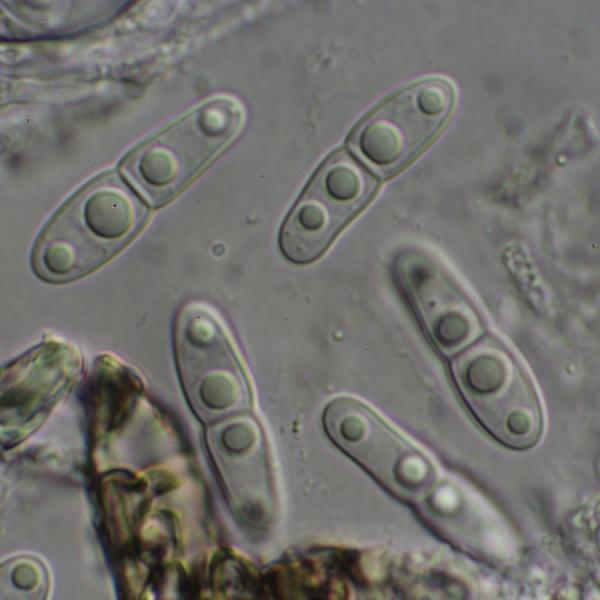Naetrocymbe nitescens (Salwey ex Mudd) M.B. Aguirre, P.F. Cannon & Minter
in Minter & al., IMI Descr. Fungi Bact., 206, no. 2059: 1, 2015. Basionym: Arthopyrenia nitescens Salwey ex Mudd - Man. Brit. Lich.: 303, 1861.
Synonyms:
Distribution:
Description: Thallus crustose, endosubstratic, inconspicuous, whitish to pale pinkish brown, lichenized. Perithecia black, circular to slightly ellipsoid, mostly scattered, 0.15-0.2(0.25) x 0.12-0.17 mm, the ostiole central, situated in a slight depression. Involucrellum dimidiate, incorporating bark cells, 15-20 μm thick, brown in water, K-; exciple thin, usually colourless, surrounding the centrum; pseudoparaphyses 1.5-2.5(-3) µm thick, persistent, much branched, more or less moniliform, the cells 3-8 µm long. Asci 8-spored, obpyriform or obclavate, fissitunicate, with two functional wall layers, with a distinctive apical region lacking a nasse, 40-60 x (12-)16-23 µm. Ascospores 1-septate, weakly constricted at septum, with equal, usually biguttulate cells, or the lower cell becoming narrower towards the tip, hyaline but sometimes turning brownish and warted when overmature, (18-)20-26(-29) x 4.5-5(-6) µm, with an indistinct perispore. Pycnidia frequent, black to black-brown, 30-40 µm in diam. Conidia bacilliform, 2.8-4 x 0.8-1 µm. Photobiont trentepohlioid. Spot tests: thallus K-, C-, KC-, P-, UV-. Chemistry: without lichen substances.Note: a mainly western species, also reported from eastern France (Savoie, Roux & Coll. 2025), growing on the smooth bark of deciduous trees. To be looked for in Italy.
Growth form: Crustose
Substrata: bark
Photobiont: Trentepohlia
Reproductive strategy: mainly sexual
Most common in areas with a humid-warm climate (e.g. most of Tyrrenian Italy)
Pioneer species

Predictive model
Growth form: Crustose
Substrata: bark
Photobiont: Trentepohlia
Reproductive strategy: mainly sexual
Most common in areas with a humid-warm climate (e.g. most of Tyrrenian Italy)
Pioneer species

Predictive model



